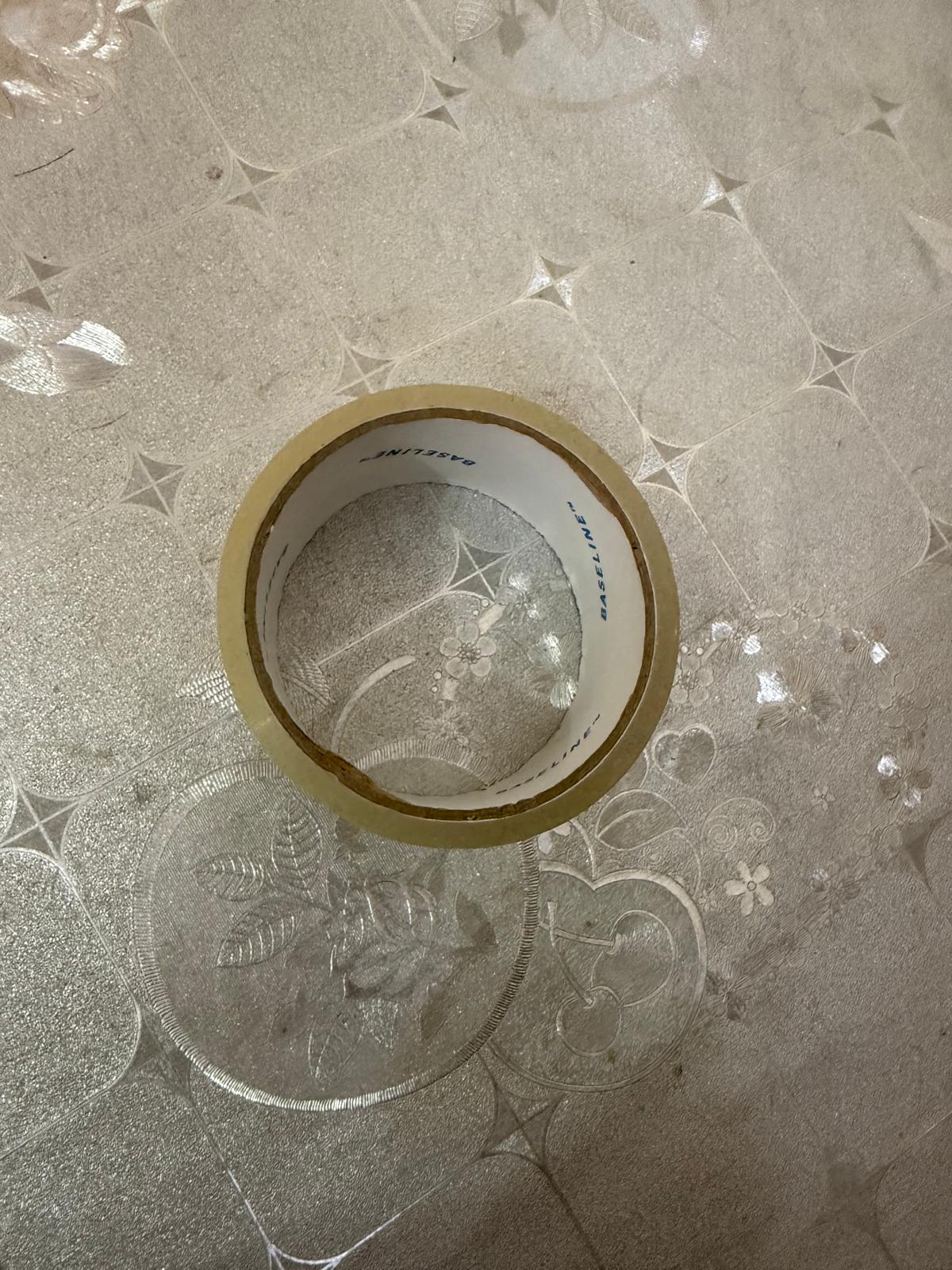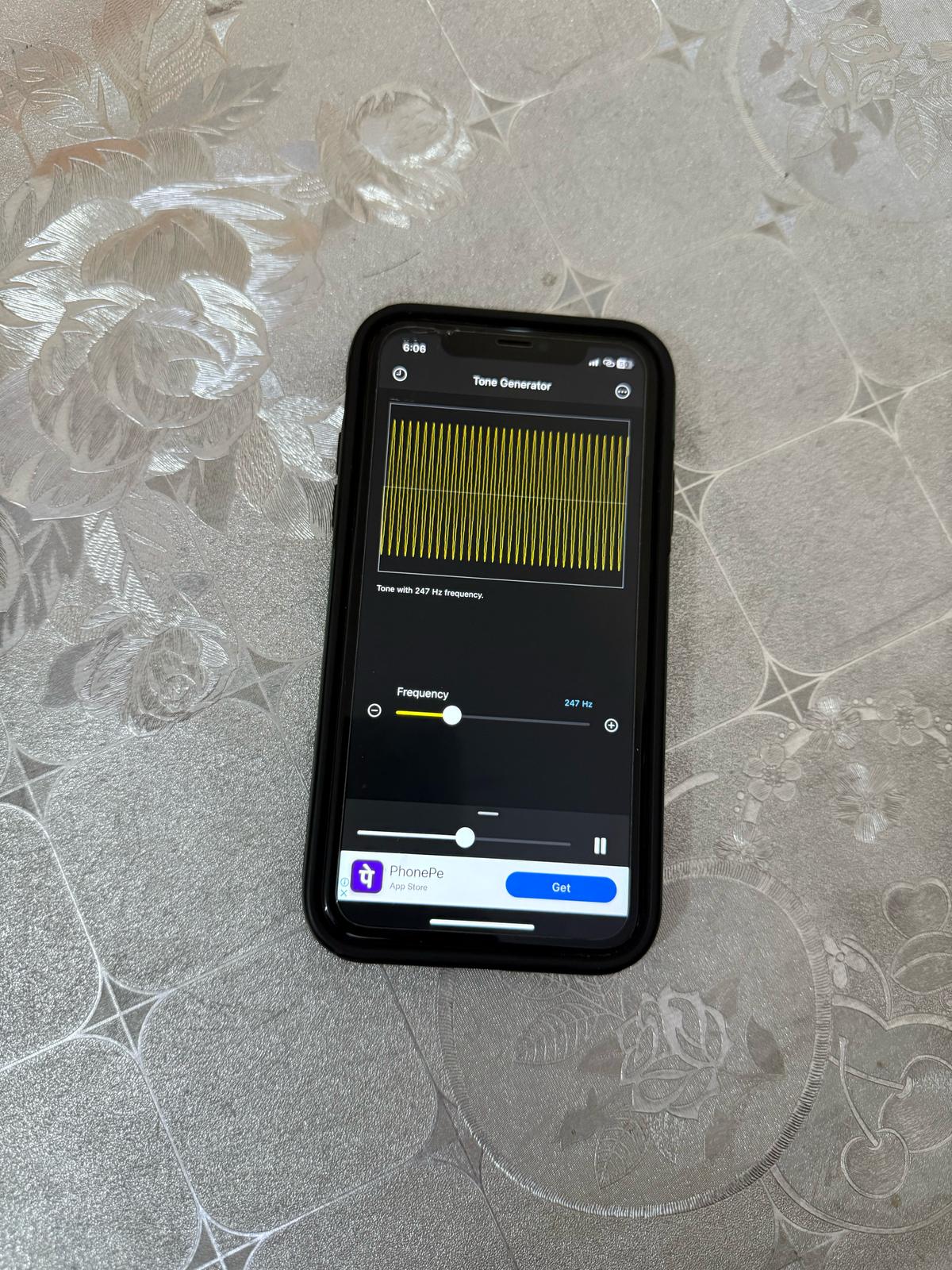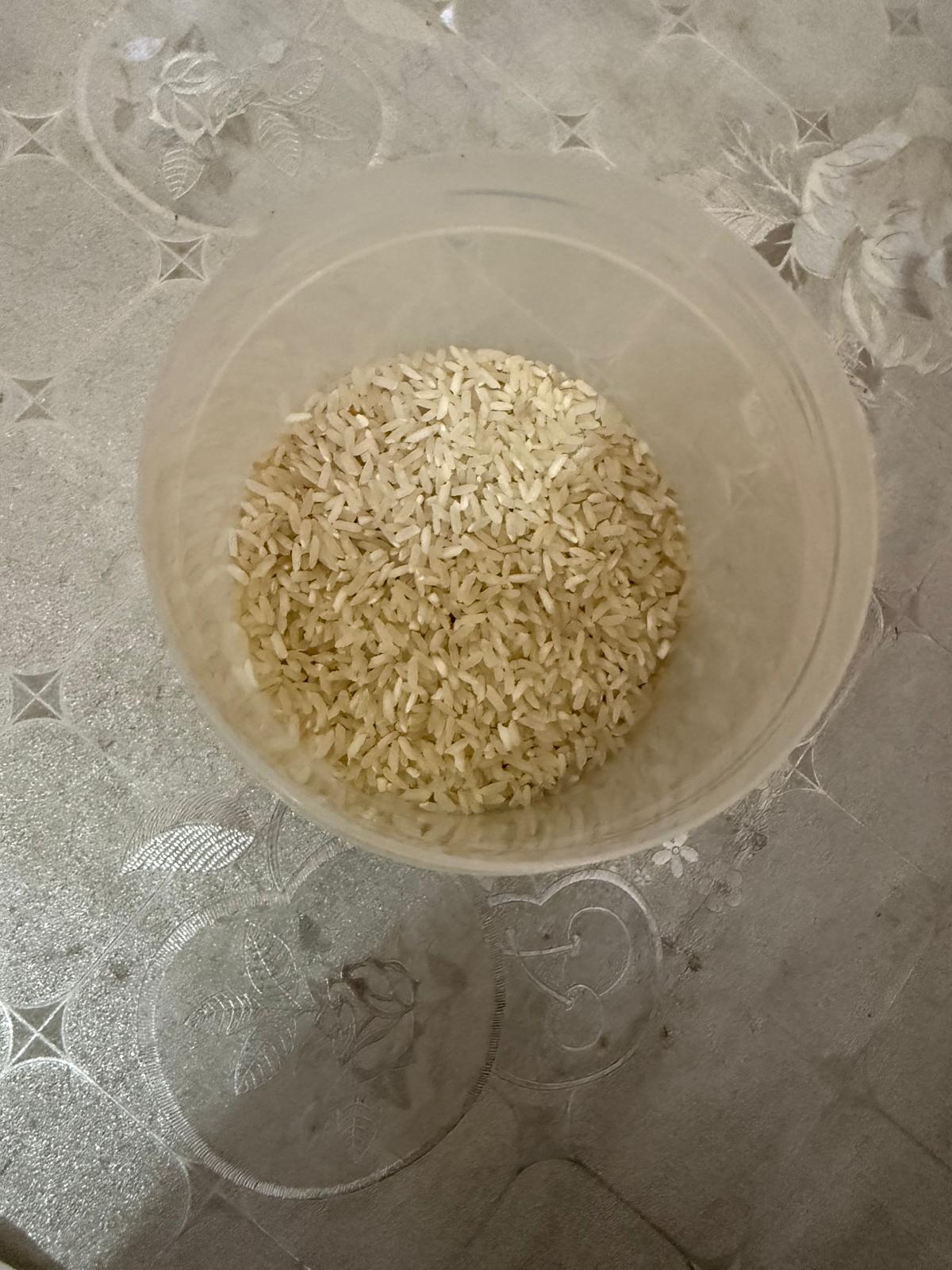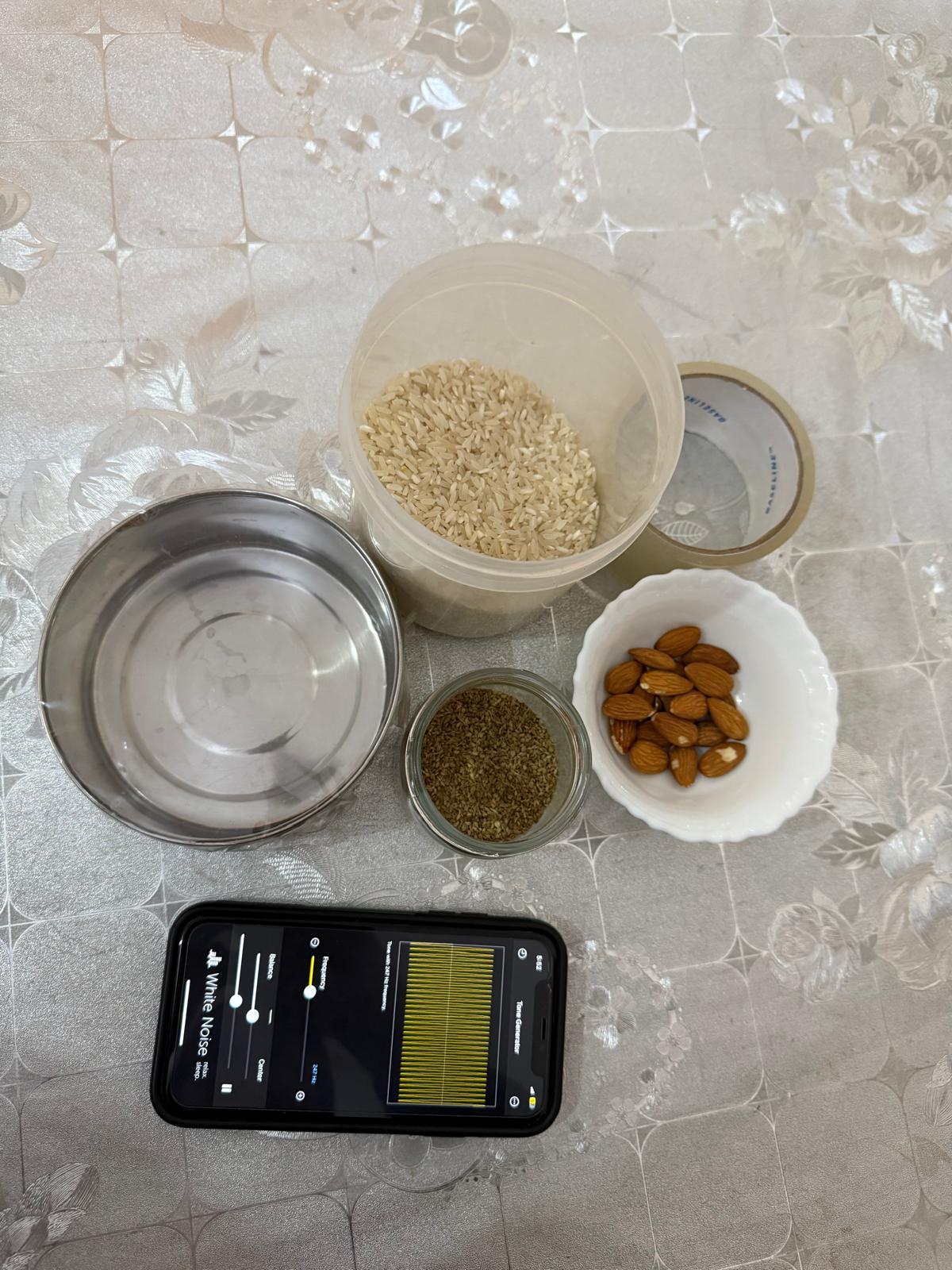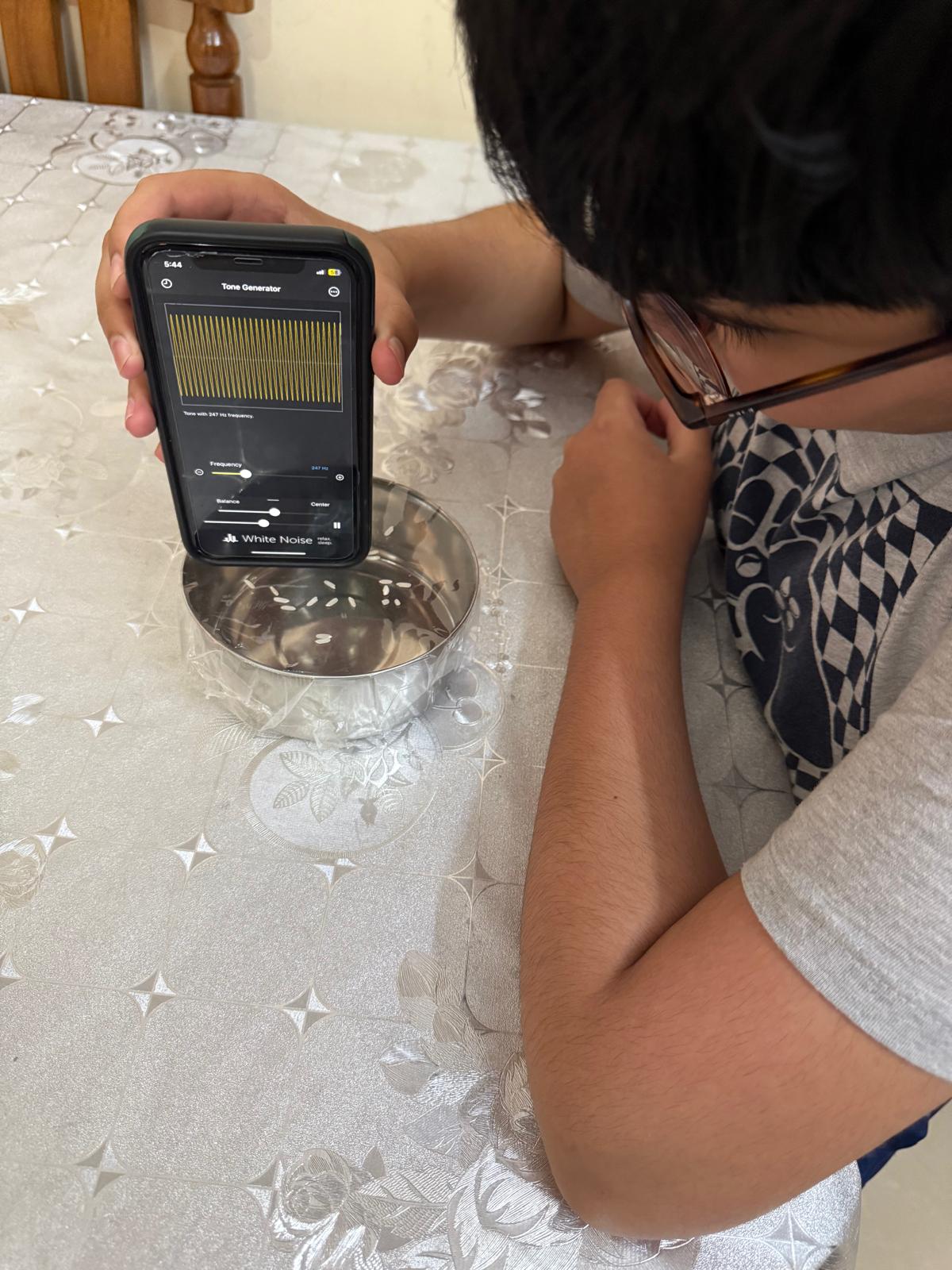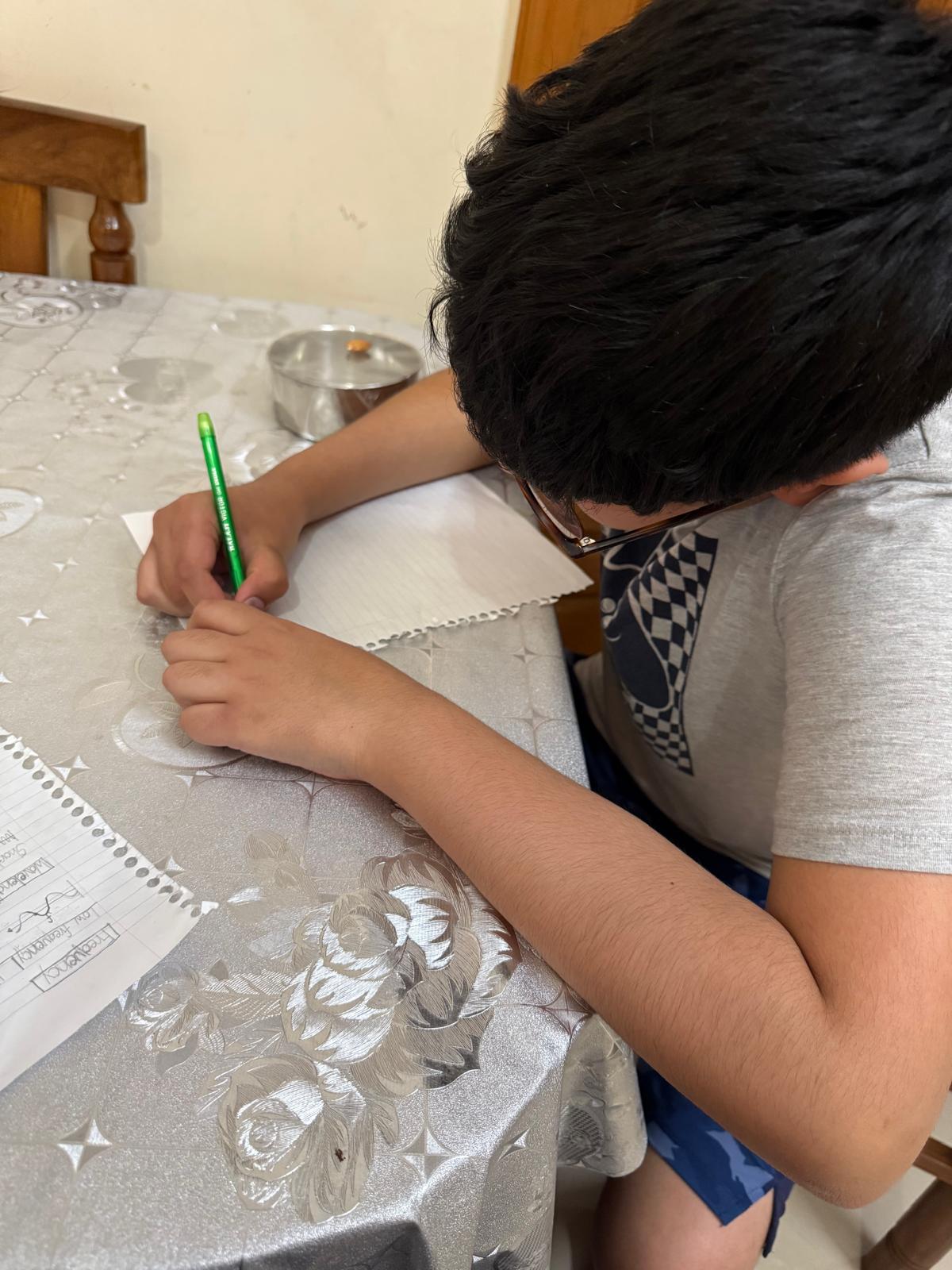Dancing to the Beat of Sound: Can Sound waves Move items?
Grade 6
Presentation
Hypothesis
My question is if it is possible to move items using sound waves. I believe that sound waves can move items, because if sound waves emit vibrations and exert force on tiny particles, then the items I will test with will move, because the sound waves will transfer their vibrations to the vibrating surface, their exerted force onto the items, and the localized pressure variations formed by the traveling sound waves should push or pull on the items. To check if my hypothesis is correct, I will be conducting an experiment to check and see if sound waves can move items.
Research
What are sound waves? How do they form?
A sound wave is a wave of compression and rarefaction. It propagates (travels) through a medium, such as air or water, by causing surrounding particles to vibrate. Compressions are regions of high pressure within the wave, while rarefactions are regions of low pressure. Sound waves form when an object vibrates, generating a pressure wave that travels through a medium. As the wave travels, its intensity gradually decreases as it moves further from the source.
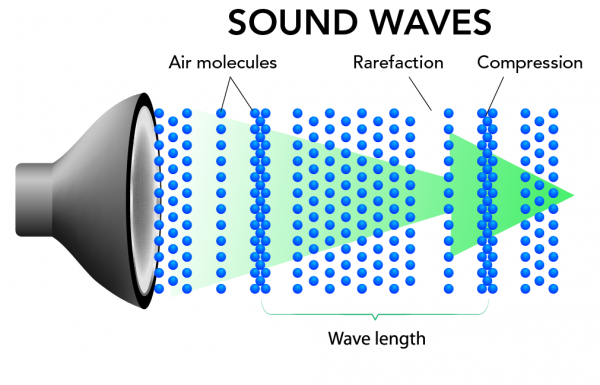
What are localized pressure differences?
Localized pressure differences refer to tiny variations in air pressure that occurr in specific areas when a sound wave travels through a medium.
Do sound waves exert force?
Yes, sound wave do exert force. The strength of a sound wave's exerted force is so strong that it can move tiny particles, like seeds!
What are the 5 main properties of a sound wave?
The five main properties of a sound wave are its frequency, wavelength, amplitude, time period, and velocity.
What is frequency?
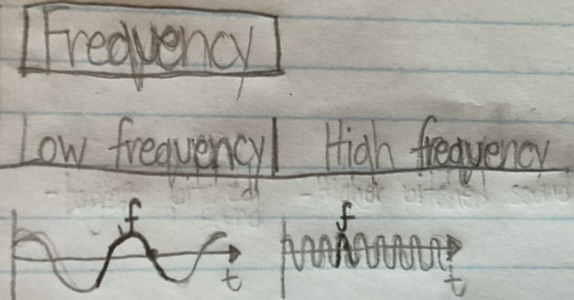
The frequency of a sound wave is the number of sound waves (cycles) that pass a given point on a sound wave. Frequency is measured in Hertz (Hz). Low frequency sound waves are low pitched and have less energy and vice versa. To find the frequency of a sound wave, we can use multiple formulas, depending on what we know about the sound wave.
Formula 1.

If we know the amount of seconds that the sound wave takes to complete one cycle, we can use the formula F = 1 / T. Ex. If we know that it takes 0.7 seconds for a sound wave to complete one cycle, we can use this formula. If we plugin the values, we get F = 1 / 0.7s. Solving this equation will approximately give us 1.43, so the frequency of the sound wave is approximately 1.43 Hertz.
Formula 2.
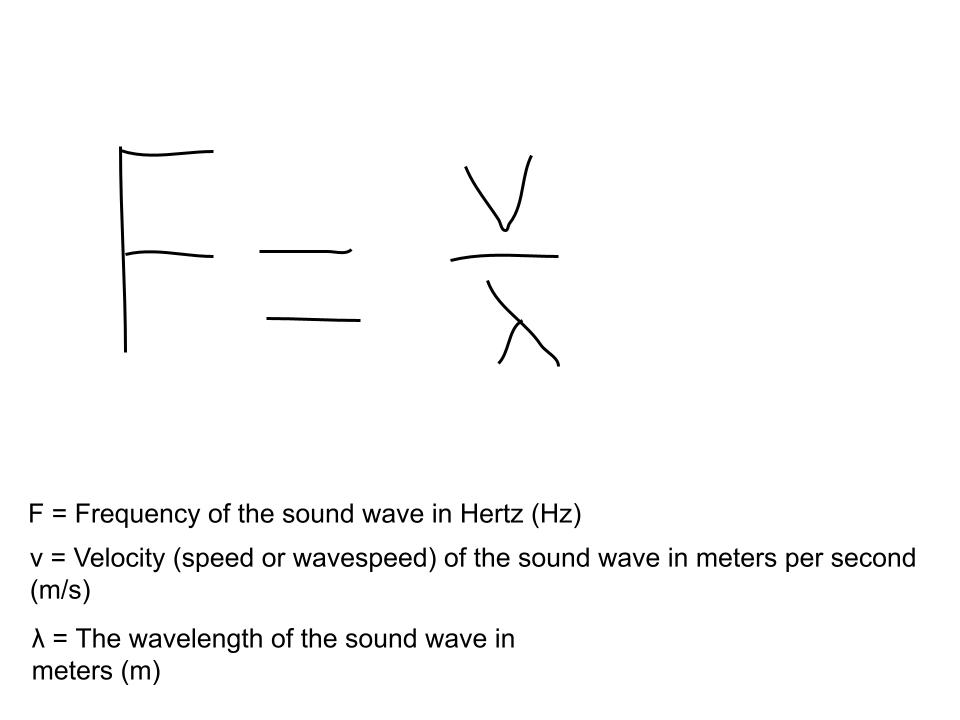
If we know the velocity (speed or wavespeed) of the sound wave in meters per second (m/s), and the wavelength of the sound wave in meters (m), we can use the formula F = v / (lowercase lambda sign). Ex. If we know that the velocity of a sound wave is 21 m/s, and the wavelength of that sound wave is 3m, we can use this formula. If we plugin the values, and remove the m/s and the m sign, we get F = 21 / 3 . Solving this equation will give us an answer of 7, so the frequency of the sound wave is 7 Hertz.
What is wavelength?

The wavelength of a sound wave is the distance from one crest (top) or trough (bottom) of a sound wave to the next. Wavelength is measured in meters (m). Short wavelength sound waves are high pitched and have more energy and vice versa. To find the wavelength of a sound wave, we can use the formula below.
Formula.
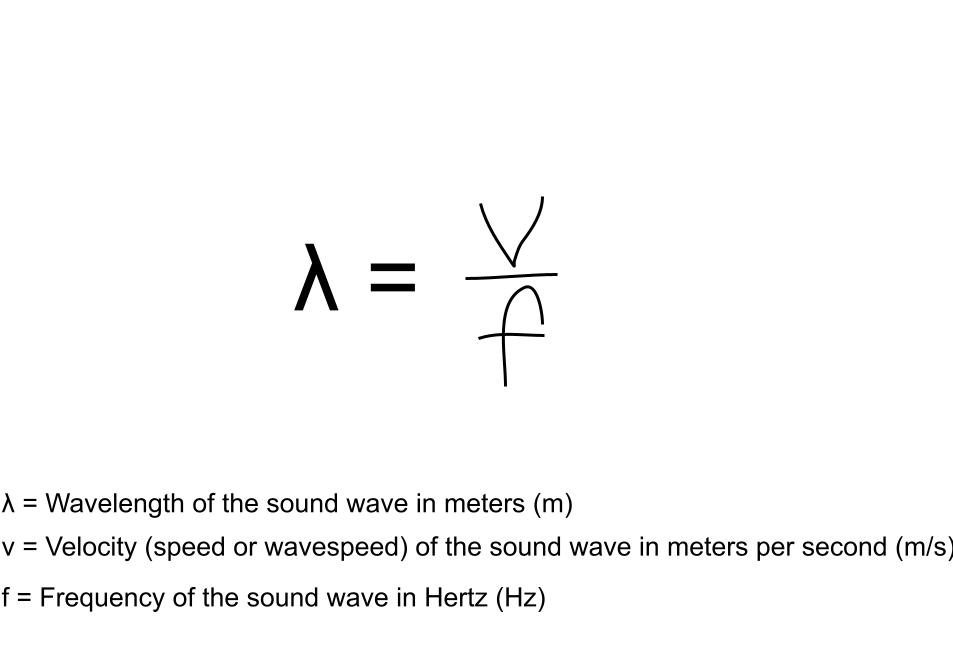
If we know the velocity (speed or wavespeed) of the sound wave in meters per second (m/s), and the frequency of the sound wave in Hertz (Hz), we can use the formula (delta sign) = v / f. Ex. If we know that the velocity of a sound wave is 314 m/s (meters per second), and the frequency of that sound wave is 213 Hertz, we can use this formula. If we plugin the values, and remove the m/s and Hertz sign, we get (delta sign) = 314 / 213. Solving this equation will approximately give us 1.47, so the wavelength of the sound wave is 1.47m.
What is amplitude?
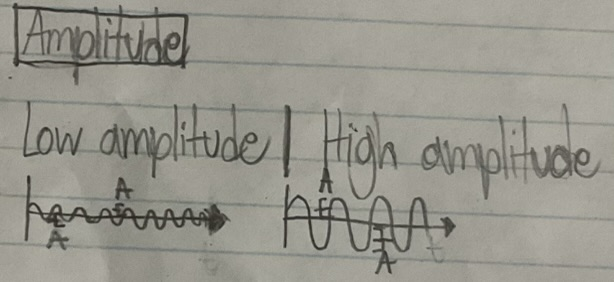
The amplitude of a sound wave is the maximum displacement of a crest or trough on a sound wave from its equilibrium position (middle line). Amplitude is measured in meters (m). Low amplitude sound waves have quiter, softer sounds and less energy and vice versa. To find the amplitude of a sound wave, we can use the formula below.
Formula.

If we know the intensity of the sound wave in watts per meter squared (W/m^2), the density of the medium that the sound wave travels through in kilograms per cubic meter (kg/m^3), and the speed of sound in the medium in meters per second, we can use this formula. The intensity of a sound wave refers to the amount of energy a sound wave carries per unit area. Ex. If we know that the intensity of a sound wave is 10 W/m^2, the density of the medium that the sound wave is in is 1000kg/m^3, and the speed of sound in the medium that the sound wave is in is 343m/s, we can use this formula. If we plugin in the values, and remove the w/m^2, kg/m^3, and m/s sign, we get the equation A = squareroot(2x10 / 1000x343 ). Solving this equation will approximately give us 0.007636, so the amplitude of the sound wave is approximately 0.007636 m.
What is time period?
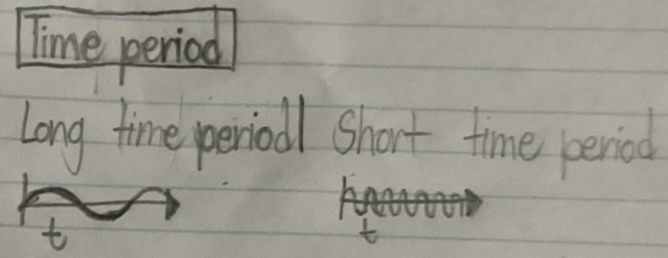
The time period of a sound wave is the amount of time taken for a sound wave to complete one cycle. Time period is measured in seconds (s). Longer time period sound waves take more time to finish one wave cycle (cycle) and have low pitched sounds, and vice versa. To find the time period of a wave, we can use the formula below.
Formula.
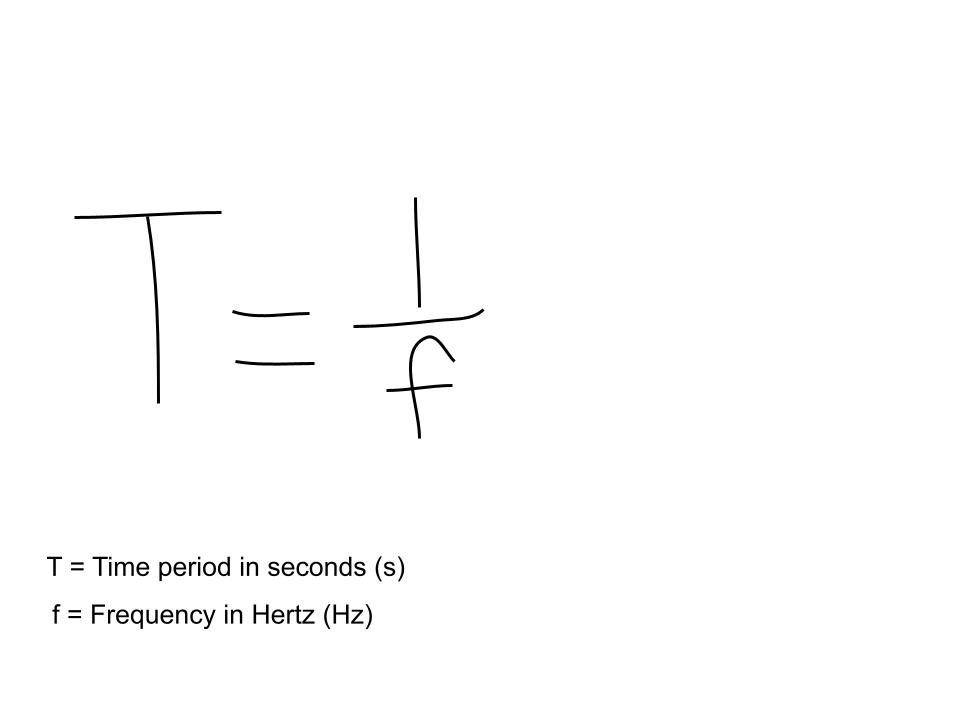
If we know the frequency of a sound wave, we can use the formula above. Ex. If we know that the frequency of a wave is 350 Hz, we can use this formula. If we plugin in the values, and remove the seconds and Hertz signs, we get the equation T = 1/350. Solving this equation will approximately give us 0.00286, so the time period of the sound wave is approximately 0.00286 s.
What is velocity?

The velocity of a sound wave is how fast a sound wave propagates (travels) through a medium. Velocity is measured in meters per second (m/s). Higher velocity sound waves travel through mediums faster and vice versa. The velocity of a sound wave can change depending on the medium's density, etc. However, if we ignore all of these factors that affect the velocity of the sound wave, we can use the formula below.
Formula.
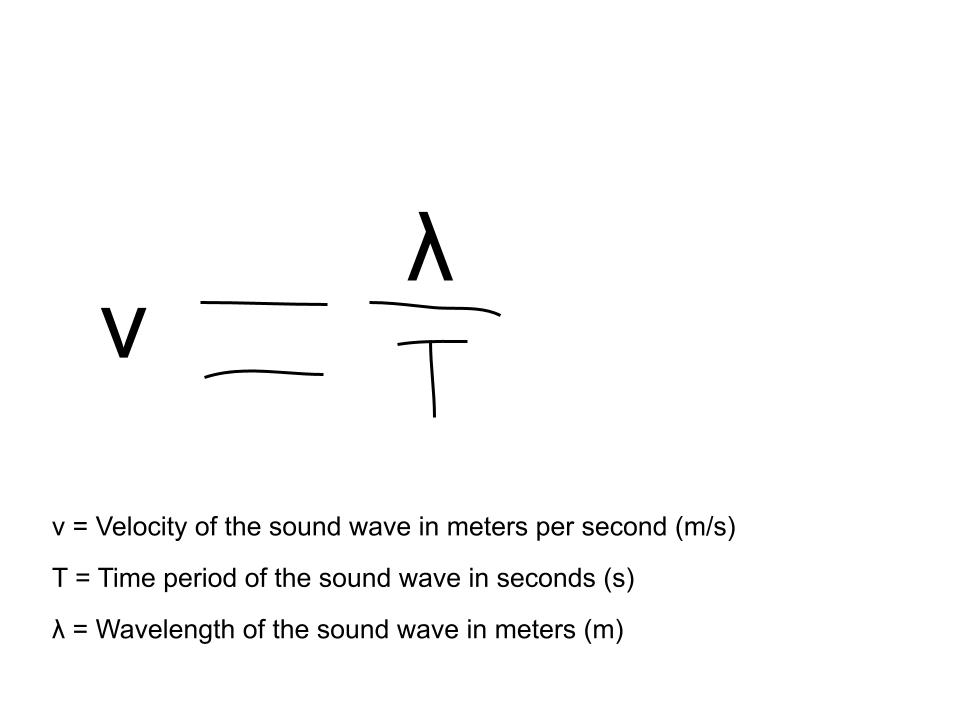
If we know the wavelength of the sound wave in meters (m), and the time period of the sound wave in seconds (s), we can use the formula above. Ex. If we know that the wavelength of a sound wave is 8 m, and the time period of the sound wave is 0.012 s, we can use this formula. If we plugin the values and remove the meters and seconds sign, we get the equation v = 8/0.012. Solving this equation will approximately give us 666.67, so the velocity of the sound wave is approximately 666.67 m/s.
Variables
Responding Variable (The result or effect that occurs due to changes in the independent variables)
- The movement, shaking, rotation, oscillation, and/or attraction to the sound source of the items on the plastic wrap when exposed to sound waves.
Manipulated Variable (What is intentionally changed)
- The type of items placed on the plastic wrap.
- The frequency of the sound waves.
Controlled Variables (What remains the same to ensure consistency)
- The plastic wrap and its tension.
- The amount of plastic wrap and tape used.
- The sound source and volume (not frequency) of the sound played
- The environment (Indoors) where the experiment takes place
Procedure
Materials:
- Plastic wrap
- Tape
- A container of any type
- A sound source, such as a phone
- Light-weight items like fennel seeds
Procedure:
- Take your container and tightly secure a piece of plastic wrap over the top of it using tape, ensuring that there are no wrinkles.
- Sprinkle a small amount of lightweight items, such as fennel seeds, on top of the plastic wrap. Make sure that the items are evenly spread out and not too close to each other.
- Use a sound source, such as a phone, and position the speaker part(s) directly above or gently touching the plastic wrap.
- Play sounds at different frequencies and see if you notice any trends, patterns, or anything unexpected that surprised you.
- Record your results for each frequency tested.
Observations
Here are my observations for what happened to my items (Carom seeds, flower petal, almond, and rice) when I played the sound from my phone.
Carom seeds:
| Frequency (Hz): | Trial 1: | Trial 2: | Trial 3: | Trial 4: | Trial 5: |
| 50 Hz | The seeds shook and moved very slightly and were very slightly attracted to the sound source. | Trials 2 - 5: The results were similar to those in trial 1. | --- | --- | --- |
| 250 Hz | The seeds moved and shook significantly more, appearing to "dance" rather than move directly toward the sound source. | The results were similar to those in the previous trial, but the seeds showed a stronger attraction to the sound source. | Trials 3 - 5: The results were identical to those in trial 2. | --- | --- |
| 1000 Hz | The seeds vigorously shook and moved across the vibrating surface, showing a strong attraction to the sound source. | The seeds shook and moved significantly. They showed a slightly strong attraction to the sound source. | Trials 3 - 5: The results were consistent with those in trial 2. | --- | --- |
| 2500 Hz | The seeds shook and moved moderately. They shifted toward the sound source but displayed more shaking and movement rather than direct attraction. | Trials 2 - 3: The results were equivalent to those in trial 1. | --- | The results were similar to those in the previous two trials, but the seeds shook and moved slightly more. | Trial 5: The results were similar to those in trial 4. |
| 5000 Hz | The seeds moved slowly and shook slightly. They gradually shifted toward the sound source. | Trials 2 - 5: The results were unchanging and were similar to those in trial 1. | --- | --- | --- |
| 10000 Hz | The seeds showed no signs of movement, shaking, or attraction to the sound source. | Trials 2 - 5: The results remained unaltered and were similar to those in trial 1. | --- | --- | --- |
Flower Petal:
| Frequency (Hz): | Trial 1: | Trial 2: | Trial 3: | Trial 4: | Trial 5: |
| 50 Hz | The petal exhibited no movement, shaking, or attraction to the sound source. | Trials 2 - 5: The results were identical to those in trial 1. | --- | --- | --- |
| 250 Hz | The petal exhibited some movement and shaking and slowly shifted toward the sound source. | The petal oscillated slightly, with its sides moving up and down, while continuing to shift toward the sound source. | Trial 3: The results were consistent with those in trial 2. | The petal continued to move and oscillate slightly, but then had a sudden burst and quickly travelled to the sound source. |
Trial 5: The results were similar to those in trials 2 & 3.
|
| 1000 Hz | The petal moved and shook slightly more and showed a slightly stronger attraction to the sound source. |
Trials 2 - 5: The results remained the same as those in trial 1. |
--- | --- | --- |
| 2500 Hz | The petal shook and moved even more and showed a slightly attraction to the sound source. | Trials 2 - 5: The results were similar to those in trial 1. | --- | --- | --- |
| 5000 Hz | The petal exhibited slightly less movement, shaking, and a weak attraction to the sound source. | Trials 2 - 5: The results were consistent to those in trial 1. | --- | --- | --- |
| 10000 Hz | The petal showed no signs of movement, shaking, or attraction to the sound source. | Trials 2 - 5: The results remained unchanged, similar to those in trial 1. | --- | --- | --- |
Almond:
| Frequency (Hz): | Trial 1: | Trial 2: | Trial 3: | Trial 4: | Trial 5: |
| 50 Hz | The almond showed no signs of shaking, movement, or attraction to the sound source. | Trials 2 - 5: The results remained the same as those in trial 1. | --- | --- | --- |
| 250 Hz | The almond showed very little oscillation with its pointy sides going up and down. It was not attracted to the sound source. | Trials 2 - 3: The results were equivalent to those in trial 1. | --- | The results were similar to those in trials 1 - 3, but the almond showed a very weak attraction to the sound source. | Trial 5: The results were similar to those in trials 1 - 3. |
| 1000 Hz | The almond moved and shook slightly, rotated at a moderate speed and appeared to rock back and forth on the vibrating surface, rather than shifting to the sound source. | Trials 2 - 5: The results were unchanging and were similar to those in trial 1. | --- | --- | --- |
| 2500 Hz | The almond rotated at a slightly moderate speed and oscillated a bit with its pointy sides going up and down. It shook and moved moderately and showed a slightly weak attraction to the sound source. | Trials 2 - 5: The results remained unaltered and were similar to those in trial 1. | --- | --- | --- |
| 5000 Hz | The almond showed very little oscillation with its pointy sides going up and down. The almond shook and moved slowly and showed a very weak attraction to the sound source. | Trials 2 - 5: The results were equivalent to those in trial 1. | --- | --- | --- |
| 10000 Hz | The almond showed no signs of movement, shaking, rotation, oscillation, or attraction to the sound source. | Trials 2 - 5: The results were similar to those in trial 1. | --- | --- | --- |
Rice:
| Frequency (Hz): | Trial 1: | Trial 2: | Trial 3: | Trial 4: | Trial 5: |
| 50 Hz | The rice shook and moved moderately and rotated at a moderate pace. They were moderately attracted to the sound source. One grain of rice even moved toward the sound source very quickly! | The results were equivalent to those in trial 1, no grains of rice moved toward the sound source very quickly. | Trials 3 - 5: The results were similar to those in trial 2. | --- | --- |
| 250 Hz | The rice shook and moved moderately and rotated at a moderate pace. They were slightly less attracted to the sound source. | Trials 2 - 5: The results showed no variation from those in trial 1. | --- | --- | --- |
| 1000 Hz | The rice moved and shook moderately, and rotated at a moderate pace. They had a slightly strong attraction to the sound source. | Trials 2 - 5: The results exhibited no differences from trial 1. | --- | --- | --- |
| 2500 Hz | The rice moved and shook slightly less, and rotated at a little slower pace. They had a slightly strong attraction to the sound source. | Trials 2 - 5: The results were consistent to those in trial 1. | --- | --- | --- |
| 5000 Hz | The rice barely showed some rotation and did not move and shake. They were not attracted to the sound source. | Trials 2 - 5: The results were equivalent to those in trial 1. | --- | --- | --- |
| 10000 Hz | The rice showed no signs of movement, shaking, rotation, or attraction to the sound source. | Trials 2 - 5: The results were similar to those in trial 1. | --- | --- | --- |
Analysis
In my analysis, I analyzed the effects of different frequencies on my items (Carom seeds, flower petal, almond, and rice) when sound was played from my phone, focusing on factors such as movement, shaking, rotation, oscillation, and attraction to the sound source.
Analysis
Carom seeds:
For carom seeds, very low frequencies (especially 50 Hz) and very high frequencies (especially 5000 and 10000 Hz) generally caused minimal to no movement, shaking, or attraction to the sound source. The peak action occurred at 1000 Hz, where the carom seeds moved and shook the most and had the strongest attraction to the sound source. As the sound’s frequency increased, the carom seeds moved and shook more and had a stronger attraction to the sound source. After the 1000 Hz mark, the carom seeds’ movement, shaking, and strength of their attraction to the sound source began to decrease. This shows that frequencies played around the mid-range (1000 Hz) affect the carom seeds the most.
Flower petal:
For the flower petal, very low frequencies (especially 50 Hz) and very high frequencies (especially 5000 and 10000 Hz) resulted in minimal to no movement, shaking, oscillation, or attraction to the sound source. The peak action occurred at 2500 Hz, where the flower petal moved, shook, and oscillated the most and had the strongest attraction to the sound source. After the 2500 Hz mark, the intensity of the flower petal’s movement, shaking, oscillation, and strength of its attraction to the sound source began to weaken. This shows that frequencies around the mid-range (1000–2500 Hz) affect the flower petal the most.
Almond:
For the almond, very low frequencies (especially 50 and 250 Hz) and very high frequencies (especially 5000 and 10000 Hz) resulted in minimal to no movement, shaking, rotation, oscillation, or attraction to the sound source. The most action occurred at 1000 Hz, where the almond exhibited the most movement, shaking, oscillation, rotation, and the strongest attraction to the sound source. After 1000 Hz, the almond began to move, shake, and oscillate less, rotate more slowly, and have a weaker attraction to the sound source. This suggests that frequencies around the mid-range (1000–2500 Hz) affect the almond the most.
Rice:
For the rice, very low frequencies (especially 50 Hz and 250 Hz) caused moderate movement, shaking, rotation, and attraction to the sound source. Very high frequencies (especially 5000 and 10000 Hz) caused minimal to no movement, shaking, rotation, or attraction. The peak action occurred at 1000 Hz, where the rice moved, shook, and rotated the most, with the strongest attraction to the sound source. Beyond 1000 Hz, the rice moved, rotated, and shook less, with a weaker attraction to the sound source.
Overall Analysis
Across all observations, the tested items moved, shook, and exhibited the most action at mid-range frequencies (1000–2500 Hz), with peak movement occurring at 1000 & 2500 Hz most of the time. Very low and very high frequencies often resulted in minimal to no movement, shaking, or attraction to the sound source. After the peak frequency, the items gradually moved and shook less, with weaker attraction to the sound source. At peak frequencies, the items exhibited the strongest movement and shaking, with some also displaying the most rotation and oscillation. One thing I found interesting was when the flower petal had a sudden burst of movement. At first, I thought that this meant that lower frequencies had more power in them. However, after thinking about it for some time, I realized that wasn’t true. Since higher frequencies generally affect the tested items more and lower frequencies affect them less, it wouldn’t make sense for a lower frequency to cause this sudden movement. This probably happened because I might have accidentally pushed down on the plastic with my phone, which created this sudden burst.
Were my results reliable?
My results were mainly reliable, because I mainly got consistent results through every trials of frequencies. There may have been significant variations of the results in some trials, likely due to minor inconsistencies in execution. My controlled variables also remained the same, still ensuring consistency.
Why did this happen?
Sound waves exert force and can move tiny particles. Since the tested items are lightweight, they can easily be affected by a sound wave’s vibrations and exerted force, causing them to move and shake. The tested items were attracted to the sound source because the sound waves generated by my phone’s speaker caused slight disturbances in the air. These disturbances created localized pressure differences, which pushed the items toward the sound source. Sound waves are made up of compressions (high pressure) and rarefactions (low pressure). As these pressure changes travel through a medium, they can push or pull on objects, causing them to move, shake, rotate, and/or oscillate.
Why do different frequencies cause different results?
Various frequencies cause different results because objects have different natural frequencies (The frequency at which it naturally vibrates when disturbed). Resonance occurs when a sound wave matches or comes close to an object's natural frequency, causing the object to vibrate more strongly. Objects respond differently to different frequencies depending on their mass, material, shape, and flexibility. Sound waves need more energy to move heavier objects like marbles, so low frequency sound waves with less energy aren't likely to move heavier objects. But what about extremely high frequencies? You're right! They have more energy, but extremely high frequencies don't work well either---their waves are too fast for objects to respond effectively.
Conclusion
In this experiment, I have tested if it is possible to move items using sound waves by performing an experiment with plastic wrap, a container, tape, items, and a sound source. I observed how different frequencies affected the movement of different items and noted any trends or patterns.
Generally, my tested items exhibited peak movement, shaking, rotation, oscillation, and the strongest attraction to the sound source at 1000 and 2500 Hz. Very high and low frequencies often resulted in minimal to no movement, shaking, rotation, oscillation, and strength of attraction to the sound source.
My hypothesis, which was that sound waves can move items, ended up being partially correct. I know this because in my hypothesis, I said that sound waves can move items, but in my analysis, I also observed shaking, rotation, oscillation, and attractions to the sound source, proving my hypothesis partially correct.
My tested items moved and shook due to their light weight, causing them to be easily affected by the sound wave's vibrations and exerted force. Sound waves are composed of compressions and rarefactions, and as these pressure changes travel through a medium, they can push or pull on objects. My items were attracted to the sound source due to the sound waves created by my phone's speaker causing slight disturbances in the air. These disturbances created localized pressure differences (localized pressure variations), which pushed the items toward the sound source. Different frequencies affect objects differently because every object has a natural frequency. When a sound wave's frequency matches the natural frequency of an object, it causes resonance, which makes the object vibrate more strongly.
Some sources of errors may have affected my results, causing some variations. Overall, my results were mainly consistent.
Some suggestions for improvement are
- Testing with other materials other than plastic wrap.
- Conducting more trials to ensure better consistency.
- Testing with more items.
- Getting a larger sound source to try and move heavier objects.
Note: If heavier items like screws or nuts did not move with a phone speaker, a more powerful sound source, such as a subwoofer, may be needed.
Application
The results of the experiment help us understand how sound waves interact with different materials, which has various practical applications. A key area is soundproofing, engineers can design materials that can either absorb or amplify sound. This concept can be useful especially useful in concert halls and everyday buildings to improve acoustics and help reduce unwanted noise.
Another is levitation and transportation, scientists use sound waves to levitate small objects, which could have possible future applications in space exploration or new forms of transport.
One more application is designing instrument, understanding how different frequencies can affect materials can be useful for designing instruments with better sound resonance.
Sources Of Error
There were a couple of possible sources of error in my experiment:
- Limited trials. I could have done more trials for more reliable results, which could have taken up more time, making me rush the other parts of the project.
- Accidental pressure on plastic wrap. I might have accidentally pressed down slightly on the plastic wrap with my phone, possibly making them fall closer to the sound source and possibly affecing my results.
- Volume issues. I might have forgotten to set the volume of my phone to its max capacity every trial, which could have weakened the intensity of the sound waves, possibly affecting how much the items moved.
- Tension of plastic wrap. The plastic wrap might not have been stretched tightly enough, which could have caused bumps on the plastic wrap, possibly affecting the results
- Minor inconsistencies. There may have been some minor inconsistencies during the execution of my experiment, possibly affecting the results.
Citations
"What is a sound wave?", Author: Andrew Zola, techtarget.com, https://www.techtarget.com/whatis/definition/sound-wave#:~:text=A%20sound%20wave%20is%20the,for%20example%2C%20a%20ringing%20cellphone, Last Updated: June 2022
"What is sound?", Author: soundproofcow.com, https://www.soundproofcow.com/soundproofing-101/whatissound/?srsltid=AfmBOopxjYSuZBaRuBt1mGIYP8CrtEO86ICf1DkksqvKOk0Xt9ljxg2Z, Last Updated: Not written
Author: oceanexplorer.noaa.gov, https://oceanexplorer.noaa.gov/explorations/sound01/background/acoustics/media/sinewave.html#:~:text=The%20basic%20components%20of%20a%20sound%20wave%20are%20frequency%2C%20wavelength,or%202%20Hertz%20(Hz), Last Updated: Not written
"What is frequency?", Author: Courtney Durso, study.com, https://study.com/learn/lesson/frequency-formula-unit-examples-wave.html#:~:text=Frequency%20is%20the%20number%20of,speed%20divided%20by%20the%20wavelength, Last Updated: November 21, 2023
"Wavelength", Author: scied.ucar.edu, https://scied.ucar.edu/learning-zone/atmosphere/wavelength#:~:text=The%20wavelength%20of%20a%20wave,same%20value%20for%20the%20wavelength, Last Updated: Not written
(Doesn't work for some reason), Author: ???, lavelle.chem.ucla.edu, https://lavelle.chem.ucla.edu/forum/viewtopic.php?t=64783#p252830 Last Updated: ???
"Amplitude of a wave", Author: byjus.com, https://byjus.com/physics/amplitude-frequency-period-sound/ Last Updated: Not written.
"Sound Energy Activity", Author: theteacherscafe.com, https://theteacherscafe.com/Science/Hands_On_Activity/Sound_Energy_Activity.php Last Updated: Not written.
"4 ways to calculate frequency", Co-author: Kevin Wang, wikihow.com, https://www.wikihow.com/Calculate-Frequency, Last Updated: September 19, 2024.
"How to calculate wavelength", Co-author: Meredith Juncker, wikihow.com, https://www.wikihow.com/Calculate-Wavelength, Last Updated: March 3, 2025.
"What is sound?", Author: Jonathan Hana, pasco.com, https://www.pasco.com/resources/articles/sound-waves#:~:text=There%20are%20five%20main%20characteristics,travels%20before%20it%20repeats%20itself, Created: August 1, 2024.
"Speed of sound", Author: OpenStax, phys.libretexts.org, https://phys.libretexts.org/Bookshelves/University_Physics/University_Physics_(OpenStax)/Book%3A_University_Physics_I_-_Mechanics_Sound_Oscillations_and_Waves_(OpenStax)/17%3A_Sound/17.03%3A_Speed_of_Sound#:~:text=The%20equation%20for%20the%20speed%20of%20sound%20in%20air%20v,s%E2%88%9AT273K, Last Updated: Not written.
"Energy in waves: intensity", Author: OpenStax College, courses.lumenlearning.com, https://courses.lumenlearning.com/suny-physics/chapter/16-11-energy-in-waves-intensity/, Last Updated: Not written.
"Characteristics of sound waves: amplitude, frequency, wavelength and timbre", Author: byjus.com, https://byjus.com/physics/characteristics-of-sound-wavesamplitude/, Last Updated: Not written.
"Intensity", Author: Gleen Elert, physics.info, https://physics.info/intensity/, Last Updated: Not written.
"Amplitude, time period, frequency", Author: yaclass.in, https://www.yaclass.in/p/science-cbse/class-8/sound-18244/sound-production-and-pollution-4556/re-f1ccff9d-0a4f-4b0e-baad-90ba7abe7a6f, Last Updated: Not written.
Images:
Acknowledgement
I would like to thank my teachers, Ms. Kale and Ms. Schulte, for their guidance and for patiently answering all of my endless questions.
I would also like to give special thanks to my Mama (my hero), for providing me with all the materials I needed for this project, helping me assemble a part of the project, and rooting for me to go to the CYSF.



